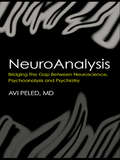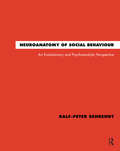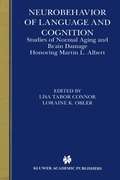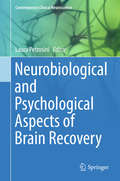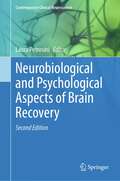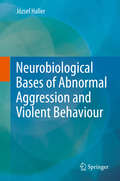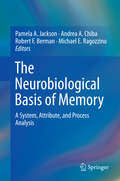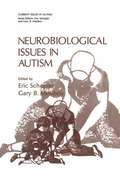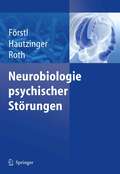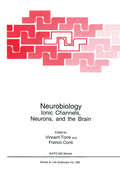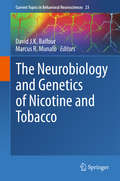- Table View
- List View
NeuroAnalysis: Bridging the Gap between Neuroscience, Psychoanalysis and Psychiatry
by Avi PeledNeuroAnalysis investigates using the neural network and neural computation models to bridge the divide between psychology, psychoanalysis, and neuroscience when diagnosing mental health disorders and prescribing treatment. Avi Peled builds on Freud's early attempts to explain the neural basis of mental health by introducing neural computation as a bridging science to explain psychiatric disorders. Peled describes the brain as a complex system of interconnected units and goes on to suggest that conscious experience, feelings, and mood are emergent properties arising from these complex organisations. This model describes mental health disorders in terms of perturbation to the optimal brain organisation, and demonstrates how particular disorders can be identified through a specific breakdown pattern of the brain’s organisation. This fresh approach to the diagnosis of psychiatric disorders will interest students, professors, and researchers of psychoanalysis, neuroscience, and their related fields.
Neuroanatomy of Language Regions of the Human Brain
by Michael PetridesMany studies of the neural bases of language processes are now conducted with functional and structural neuroimaging. Research is often compromised because of difficulties in identifying the core structures in the face of the complex morphology of these regions of the brain. Although there are many books on the cognitive aspects of language and also on neurolinguistics and aphasiology, Neuroanatomy of Language Regions of the Human Brain is the first anatomical atlas that focuses on the core regions of the cerebral cortex involved in language processing. This atlas is a richly illustrated guide for scientists interested in the gross morphology of the sulci and gyri of the core language regions, in the cytoarchitecture of the relevant cortical areas, and in the connectivity of these areas. Data from diffusion MRI and resting-state connectivity are integrated iwth critical experimental anatomical data about homologous areas in the macaque monkey to provide the latest information on the connectivity of the language-relevant cortical areas of the brain. Although the anatomical connectivity data from studies on the macaque monkey provide the most detailed information, they are often neglected because of difficulties in interpreting the terminology used and in making the monkey-to-human comparison. This atlas helps investigators interpret this important source of information. Neuroanatomy of Language Regions of the Human Brain will assist investigators of the neural bases of language in increasing the anatomical sophistication of their research adn in evaluating studies of language and the brain. - Abundantly illustrated with photographs, 3-D MRI reconstructions, and sections to represent the morphology of the sulci and gyri in the frontal, temporal, and parietal regions involved in language processing - Photomicrographs showing the cytoarchitecture of cortical areas involved in language processing - Series of coronal, sagittal, and horizontal sections identifying the sulci and gyri to assist language investigators using structural and functional neuroimaging techniques - All images accompanied by brief commentaries to help users navigate the complexities of the anatomy - Integration of data from diffusion MRI and resting-state connectivity with critical experimental anatomical data on the connectivity of homologous areas in the macaque monkey
Neuroanatomy of Social Behaviour: An Evolutionary and Psychoanalytic Perspective
by Ralf-Peter BehrendtThis book is for readers who are knowledgeable about the neurosciences and curious about brain mechanisms that produce normal and pathological social behaviour. It is a reference work that presents and reviews facts and recent findings that need to be accounted for within a coherent neuroanatomy and neurophysiology of social behaviour.
Neuroanatomy of Social Behaviour: An Evolutionary and Psychoanalytic Perspective
by Ralf-Peter BehrendtThis book is for readers who are knowledgeable about the neurosciences and curious about brain mechanisms that produce normal and pathological social behaviour. It is a reference work that presents and reviews facts and recent findings that need to be accounted for within a coherent neuroanatomy and neurophysiology of social behaviour.
Neurobehavior of Language and Cognition: Studies of Normal Aging and Brain Damage
by Loraine K. Obler Lisa TaborConnorThis volume has been composed as an appreciation of Martin L. Albert in the year of his 60th birthday. At least one contributor to each paper in this volume has been touched by Marty in some way; lie has mentored some, been a fellow student with some, and been a colleague to most. These contributors, as well as many others, view Marty as a gifted scientist and a wonderful human being. The breadth of his interests and intellectual pursuits is truly impressive; this breadth is reflected, only in part. by the diversity of the papers in this volume. His interests have ranged from psychopharmacology to cross-cultural understanding of dementia, through the aphasias, to the history of the fields that touch on behavioral neurology, especially neurology per se, cognitive psychology, speech-language pathology, and linguistics. Throughout his scholarly work, Martha Taylor Sarno notes, Marty never loses the human perspective, e. g. , the “powerfully disabling effect on the individual person” with aphasia or other neurological disorder. For those readers who only how a portion of his work, we thought that we should describe him here. Many of the people whom Marty has influenced have been able to contribute to this volume. We have invited some others who were unable to contribute to express their appreciation for him, as well.
Neurobehavioral Plasticity: Learning, Development, and Response to Brain Insults
by Norman E. Spear Linda P. Spear Michael L. WoodruffThis book describes a unique combination of research programs based on a striking variety of hypotheses and procedures directed toward understanding the sources and consequences of neurobehavioral plasticity. This remarkable attribute of the nervous system -- to be pliable and capable of being shaped or formed by natural or artificial sources toward adaptation or maladaptation -- is considered in terms of the neurochemical forces and neuroanatomical structure that has been found to be pivotal for this function. The impetus for this volume was a symposium held to honor Robert L. Isaacson for his scientific and pedagogical achievements as well as his contributions to behavioral neuroscience. Corresponding to his three major research interests, the book is divided into three sections as follows: * the first explores the relationship between the limbic system and behavior, with an emphasis on learning and memory; * the second considers -- through a wide range of approaches -- issues of plasticity in behavior and brain; and * the third deals with neural and chemical determinants of normal and abnormal behavior. This volume is not only a fitting tribute to Isaacson, but also an unusual collection of new evidence, procedures, and theories destined to have significant influence on behavioral neuroscience.
Neurobehavioral Plasticity: Learning, Development, and Response to Brain Insults
by Norman E. Spear Linda P. Spear Michael L. WoodruffThis book describes a unique combination of research programs based on a striking variety of hypotheses and procedures directed toward understanding the sources and consequences of neurobehavioral plasticity. This remarkable attribute of the nervous system -- to be pliable and capable of being shaped or formed by natural or artificial sources toward adaptation or maladaptation -- is considered in terms of the neurochemical forces and neuroanatomical structure that has been found to be pivotal for this function. The impetus for this volume was a symposium held to honor Robert L. Isaacson for his scientific and pedagogical achievements as well as his contributions to behavioral neuroscience. Corresponding to his three major research interests, the book is divided into three sections as follows: * the first explores the relationship between the limbic system and behavior, with an emphasis on learning and memory; * the second considers -- through a wide range of approaches -- issues of plasticity in behavior and brain; and * the third deals with neural and chemical determinants of normal and abnormal behavior. This volume is not only a fitting tribute to Isaacson, but also an unusual collection of new evidence, procedures, and theories destined to have significant influence on behavioral neuroscience.
Neurobehavioral Toxicology: Peripheral Nervous System (Studies on Neuropsychology, Neurology and Cognition #5)
by James W. Albers Stanley BerentThis book, the second of three volumes, concentrates on peripheral nervous system disorders. Examining the effects of neurotoxicants on nerve, muscle and the neuromuscular junction, it builds on the scientific principles outlined in volume 1 by looking at the application of the methods discussed, particularly in terms of the evaluation and diagnosis of individual patients and the related process of establishing causation. Neurobehavorial Toxicology, Volume 2 will be of interest to practicing neurologists and neuropsychologists, as well as to occupational medicine physicians and medical toxicologists.
Neurobehavioral Toxicology: Peripheral Nervous System (Studies on Neuropsychology, Neurology and Cognition #5)
by James W. Albers Stanley BerentThis book, the second of three volumes, concentrates on peripheral nervous system disorders. Examining the effects of neurotoxicants on nerve, muscle and the neuromuscular junction, it builds on the scientific principles outlined in volume 1 by looking at the application of the methods discussed, particularly in terms of the evaluation and diagnosis of individual patients and the related process of establishing causation. Neurobehavorial Toxicology, Volume 2 will be of interest to practicing neurologists and neuropsychologists, as well as to occupational medicine physicians and medical toxicologists.
Neurobehavioral Toxicology: Central Nervous System (Studies on Neuropsychology, Neurology and Cognition)
by Stanley Berent James W. AlbersThis is the final volume in a three-volume work that has addressed the scientific methodologies relevant to clinical neurobehavioral toxicology. Volume I focused on basic concepts and methodologies in Neurobehavioral Toxicology, with Volume II focusing on the peripheral nervous system. Volume III attends to what is known about industrial and environmental chemicals, medicines, and substances of abuse and how these agents affect the central nervous system. All substances have the capacity to be toxic, depending on factors that include the physical properties of the chemical or compound, organism related variables, or interaction between the two. These substances on the other hand and as a result of these same factors might be used therapeutically or even recreationally. The difference between medicine, recreational drug, or poison depends often on a careful balance between adverse and intended effects. How to determine that a specified substance has caused harm is emphasized in the present volume by way of case examples and discussion. Illnesses and behavioral variations that compete with toxicant-induced explanations for findings in a given case, as well as the various controversies that can arise around issues of diagnosis and causal determination, are treated comprehensively in this volume.
Neurobehavioral Toxicology: Central Nervous System (Studies on Neuropsychology, Neurology and Cognition)
by Stanley Berent James W. AlbersThis is the final volume in a three-volume work that has addressed the scientific methodologies relevant to clinical neurobehavioral toxicology. Volume I focused on basic concepts and methodologies in Neurobehavioral Toxicology, with Volume II focusing on the peripheral nervous system. Volume III attends to what is known about industrial and environmental chemicals, medicines, and substances of abuse and how these agents affect the central nervous system. All substances have the capacity to be toxic, depending on factors that include the physical properties of the chemical or compound, organism related variables, or interaction between the two. These substances on the other hand and as a result of these same factors might be used therapeutically or even recreationally. The difference between medicine, recreational drug, or poison depends often on a careful balance between adverse and intended effects. How to determine that a specified substance has caused harm is emphasized in the present volume by way of case examples and discussion. Illnesses and behavioral variations that compete with toxicant-induced explanations for findings in a given case, as well as the various controversies that can arise around issues of diagnosis and causal determination, are treated comprehensively in this volume.
Neurobehavioral Toxicology: Foundations and Methods (Studies on Neuropsychology, Neurology and Cognition #5)
by Stanley Berent James W. AlbersThis book, the first of three volumes, provides a thorough background to the emerging field of neurobehavioral toxicology by looking at current clinical approaches and tests, as well as assessing current clinical research. The analysis of the impact of toxins on the human nervous system is particularly pertinent given the ongoing expansion of pharmaceuticals, industrial hazards, biological warfare and global pollution. A comprehensive introduction to neurobehavioral toxicology, this work will be of interest to practicing neurologists and neuropsychologists, as well as to occupational medicine physicians and medical toxicologists.
Neurobehavioral Toxicology: Foundations and Methods (Studies on Neuropsychology, Neurology and Cognition)
by Stanley Berent James W. AlbersThis book, the first of three volumes, provides a thorough background to the emerging field of neurobehavioral toxicology by looking at current clinical approaches and tests, as well as assessing current clinical research. The analysis of the impact of toxins on the human nervous system is particularly pertinent given the ongoing expansion of pharmaceuticals, industrial hazards, biological warfare and global pollution. A comprehensive introduction to neurobehavioral toxicology, this work will be of interest to practicing neurologists and neuropsychologists, as well as to occupational medicine physicians and medical toxicologists.
The Neurobehavioral Treatment of Epilepsy
by David I. Mostofsky Yngve LøyningThis volume is a first of its kind, addressed principally to the professional reader. While it is not intended to be exhaustive, its aim is to sketch a broad picture of some of the nondrug and nonsurgical treatment strategies with a demonstrated basis in conventional scientific method. Likewise, though it does not include all those who have contributed to the emergence of this exciting new field, it assembles those authors whose seminal work has earned them international reputations. This volume's declared purpose is to provide a state-of-the-art guide to methods and techniques in the behavioral treatment of epilepsy and to their basis in theory. The editors hope that it will catalyze the evolution of their acceptance as standard elements, where appropriate, in the clinical activities of independent practitioners, clinics, and agencies that service those with convulsive disorders.
The Neurobehavioral Treatment of Epilepsy
by David I. Mostofsky Yngve LoyningThis volume is a first of its kind, addressed principally to the professional reader. While it is not intended to be exhaustive, its aim is to sketch a broad picture of some of the nondrug and nonsurgical treatment strategies with a demonstrated basis in conventional scientific method. Likewise, though it does not include all those who have contributed to the emergence of this exciting new field, it assembles those authors whose seminal work has earned them international reputations. This volume's declared purpose is to provide a state-of-the-art guide to methods and techniques in the behavioral treatment of epilepsy and to their basis in theory. The editors hope that it will catalyze the evolution of their acceptance as standard elements, where appropriate, in the clinical activities of independent practitioners, clinics, and agencies that service those with convulsive disorders.
Neurobehavioural Disability and Social Handicap Following Traumatic Brain Injury (Brain, Behaviour and Cognition)
by Tom M. McMillan Rodger Ll WoodNeurobehavioural disability (NBD) follows many forms of serious brain injury and is a major constraint on social independence. This book brings together a group of leading academics and practising clinicians to provide an overview of the nature of NBD, considering how it translates into social handicap, and what can be done to address associated problems, through social and behavioural rehabilitation, vocational training and family education. This fully revised edition takes into account advances in the field, exploring the range of cognitive, emotional, and behavioural effects of brain damage most commonly associated with damage to the frontal and associated structures of the brain that govern social behaviour. This edition also features increased emphasis on psychological interventions, as well as new chapters on brain imaging, pharmacotherapy and assistive technology for disability. Neurobehavioural Disability and Social Handicap Following Traumatic Brain Injury is essential reading for clinical psychologists, psychiatrists and neurologists working in brain injury rehabilitation. The book will also be of interest to relatives of those with brain injury seeking better knowledge to understand neurobehavioural disability, as well as the growing number of therapy care assistants, case managers, support workers, and social workers responsible for the day to day care of brain injured people in the community.
Neurobehavioural Disability and Social Handicap Following Traumatic Brain Injury (Brain, Behaviour and Cognition)
by Tom M. McMillan Rodger Ll WoodNeurobehavioural disability (NBD) follows many forms of serious brain injury and is a major constraint on social independence. This book brings together a group of leading academics and practising clinicians to provide an overview of the nature of NBD, considering how it translates into social handicap, and what can be done to address associated problems, through social and behavioural rehabilitation, vocational training and family education. This fully revised edition takes into account advances in the field, exploring the range of cognitive, emotional, and behavioural effects of brain damage most commonly associated with damage to the frontal and associated structures of the brain that govern social behaviour. This edition also features increased emphasis on psychological interventions, as well as new chapters on brain imaging, pharmacotherapy and assistive technology for disability. Neurobehavioural Disability and Social Handicap Following Traumatic Brain Injury is essential reading for clinical psychologists, psychiatrists and neurologists working in brain injury rehabilitation. The book will also be of interest to relatives of those with brain injury seeking better knowledge to understand neurobehavioural disability, as well as the growing number of therapy care assistants, case managers, support workers, and social workers responsible for the day to day care of brain injured people in the community.
Neurobiological and Psychological Aspects of Brain Recovery (Contemporary Clinical Neuroscience)
by Laura PetrosiniThe novelty of this book's approach lies in addressing the impact of neurobiological factors as well as psychological influences on brain recovery. There is growing evidence that emotional, motivational, and cognitive factors along with personality traits play a crucial role in brain plasticity, resilience, and recovery. Topics include synaptic and neuronal plasticity, development of brain reserves, biological markers, environmental factors, psychological profile, emotional resilience, and personality traits. By combining the latest research on neural mechanisms and on psychological resilience the authors hope that this book can lead to the development of better treatment strategies for functional recovery from brain damage.
Neurobiological and Psychological Aspects of Brain Recovery (Contemporary Clinical Neuroscience)
by Laura PetrosiniThe importance of this unique book's approach lies in addressing the impact of neurobiological factors as well as psychological influences on brain recovery following injury. There is growing evidence that emotional, motivational, and cognitive factors along with personality traits play a crucial role in brain plasticity, resilience, and recovery. Topics include synaptic and neuronal plasticity, development of brain reserves, biological markers, environmental factors, emotional resilience, and personality traits. By combining the latest research on neural mechanisms and psychological resilience the authors present a book that will help lead to the development of better treatment strategies for functional recovery from brain damage. The new edition is fully updated throughout and contains completely new chapters on brain recovery in childhood, epigenetic aspects of brain recovery, and artificial intelligence techniques in traumatic brain injury research.
Neurobiological Bases of Abnormal Aggression and Violent Behaviour
by József HallerMechanisms controlling aggressive behavior started to be identified from late 20's of the 20th century and subsequent research described such mechanisms in great detail. While the findings are of great relevance for the understanding of aggression per se, they provide limited insights into the mechanisms of abnormal aggression i.e. those mechanisms that underlie aggression-related psychopathologies. While basic phenomena and mechanism of aggression are presented, this book is the first that comprehensively describes ultimate and proximate mechanisms that transform normal (laboratory animals) or tolerable (humans) manifestations of aggressiveness into abnormal patterns in laboratory animals and aggression-related psychopathologies in humans. This book is written for behavioral neurobiologists and neuroscientists, interested in emotional control in general and aggression research in particular. The book will also offer important information to neurologists and psychiatrists dealing with aggressive behavior in the clinic and ultimately, may provide means to understand and on the long run to discover novel approaches to the treatment of abnormal human aggression.
The Neurobiological Basis of Memory: A System, Attribute, and Process Analysis
by Pamela A. Jackson Andrea A. Chiba Robert F. Berman Michael E. RagozzinoThis exciting volume offers an up-to-date tour of current trends in the neurobiology of memory while saluting Raymond Kesner's pioneering contributions to the field as a theorist and researcher, teacher and mentor. Starting with his signature chapter introducing the Attribute Model of Memory, the first half of the book focuses on the central role of the hippocampus in processing dimensions of space and time, and branches out to memory system interactions across brain structures. Later chapters apply the attribute model to multiple functions of memory in learning, and to specific neurological contexts, including Huntington's disease, traumatic brain injury, and Fragile X. As a bonus, the book concludes with an essay on Kesner's life and work, and reminiscences by colleagues. Among the topics covered: How the hippocampus supports the spatial and temporal attributes of memory.Self-regulation of memory processing centers of the brain.Multiple memory systems: the role of Kesner's Attribute Model in understanding the neurobiology of memory.Pattern separation: a key processing deficit associated with aging?· Prefrontal cortex and basal ganglia attributes underlying behavioral flexibility.Memory disruption following traumatic brain injury. Cognitive neuroscientists, neuropsychologists, gerontologists, psychiatrists, and neurobiologists will find The Neurobiological Basis of Memory both enlightening and inspiring--much like Kesner himself.
Neurobiological Issues in Autism (Current Issues in Autism)
by Eric Schopler Gary B. MesibovAs a division of the School of Medicine at the University of North Carolina at ChapeI Hili, TEACCH has always been involved in the latest biological research on autism and related developmental disabilities. However, until now there has not been sufficient information to justify aseparate volume on this most important topic. Recent advances both in our under standing of the brain and in the technology to facilitate the measurement of neurological functioning have stimulated significant growth, which is reflected in this volume. As with the preceding books in this series, Current Issues in Autism, this volume is based on one of the annual TEACCH conferences held in ChapeI Hili each May. The books are not simply published proceedings of the conference papers, however. lnstead, conference participants are asked to develop chapters around their presentations, and other international experts whose work is beyond the scope of the conference, but related to the major theme, are asked to contribute as weil. These volumes are intended to provide the most current knowledge and professional practice available to us concerning major issues in autism.
Neurobiologie psychischer Störungen
by Hans Förstl Martin Hautzinger Gerhard RothInnerhalb der letzten Jahrzehnte ist das Wissen um die neurobiologischen Grundlagen geradezu explodiert. Für die „Neurobiologie" haben interdisziplinäre Autorenteams jede Störung sowohl von psychiatrisch-neurowissenschaftlicher als auch von der psychologischen Seite genau unter die Lupe genommen. Nur wer die Grundlagen versteht kann die Störungen einordnen Vermittelt dem Leser das neurobiologische Wissen sämtlicher Störungen von A wie „Affektive Störung" bis Z wie „Zwangsstörung" Hervorragende Einführung und DAS Referenzwerk für alle Aspekte der modernen Psychiatrie
Neurobiology: Ionic Channels, Neurons and the Brain (Nato Science Series A: #289)
by Franco Conti Vincent TorreUnderstanding how the brain works is undoubtedly the greatest challenge for human intelligence and one of the most ambitious goals of contemporary science. We are certainly far from this goal, but significant advancements in several fields of Neuroscience and Neurobiology are being obtained at an increasing pace. The NATO ASI School in Neurobiology, held in Erice May 2-12,1995, as the 23rd Course of the International School of Biophysics, provided an update on three basic topics: Biophysics and Molecular Biology ofIon Channels, Sensory Transduction, and Higher Order Functions. Current knowledge on these subjects was covered by formal lectures and critical discussions between lecturers and participants. This book collects original contributions from those scientists who attended the School. Many students presented their results in poster sessions, steering lively informal discussions. A selection of these contributions is also included. A major portion of the program of the School was devoted to a general overview of current trends of thought and experimental approaches in neurobiology, emphasising the importance of understanding molecular aspects of the elementary events underlying sensory transduction and processing in the nervous system, without indulging however in a pure reductionistic view of such complex phenomena. Recent studies of molecular biology and the electrophysiology of heterologously expressed ionic channels, have shed new light on the molecular mechanisms underlying ionic permeation of excitable membranes and its regulation by physical and chemical parameters.
The Neurobiology and Genetics of Nicotine and Tobacco (Current Topics in Behavioral Neurosciences #23)
by David J. K. Balfour Marcus R. MunafòThe primary purpose of this book and its companion volume The Neuropharmacology of Nicotine Dependence is to explore the ways in which recent studies on nicotine and its role in tobacco addiction have opened our eyes to the psychopharmacological properties of this unique and fascinating drug. While the present volume considers the molecular and genetic factors which influence behavioral responses to nicotine and how these may impact on the role of nicotine in tobacco dependence, the book The Neuropharmacology of Nicotine Dependence focuses on the complex neural and psychological mechanisms that mediate nicotine dependence in experimental animal models and their relationship to tobacco addiction in humans. These volumes will provide readers with a contemporary overview of current research on nicotine psychopharmacology and its role in tobacco dependence from leaders in this field of research and will hopefully prove valuable to those who are developing their own research programmes in this important topic.
